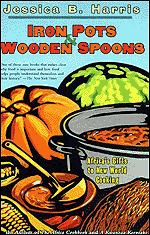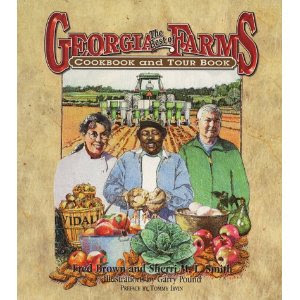Psyche A. Williams-Forson is one of our leading thinkers about food in America. In Eating While Black, she offers her knowledge and experience to illuminate how anti-Black racism operates in the practice and culture of eating. She shows how mass media, nutrition science, economics, and public policy drive entrenched opinions among Black and non-Black Americans about what is healthful and right to eat. Distorted views of how and what Black people eat are pervasive, bolstering the belief that they must be corrected and regulated. What is at stake is nothing less than whether Americans can learn to embrace nonracist understandings and practices in relation to food.
African American Foodways: Exploration of
History and Culture
Anne L. Bower
Description from the publisher:
Moving beyond catfish and collard greens to the soul of African American cooking, from seventeenth-century West African fare to contemporary fusion dishes using "soul food" ingredients, this book introduces many aspects of African American foodways. Examining the combination of African, Caribbean, and South American traditions, the volume's contributors offer insights from history, literary studies, sociology, anthropology, and African-American studies to demonstrate how food's material and symbolic values have contributed to African Americans' identity for centuries. Individual chapters examine how African foodways survived the passage into slavery, cultural meanings associated with African-American foodways, and the contents of African-American cookbooks, both early and recent.
For more than 30 years, messenger Elijah Muhammad has been teaching the so-called Negroes of America the proper foods to eat to improve their mental power and physical appearance, for prevention of illness, curing ailments, and prolonging life. Given the humble economic conditions of the blacks in America, an inexpensive yet highly nutritional diet was given to Elijah Muhammad. Before the health craze that swept the country, Elijah Muhammad and the Nation of Islam were ahead of the curve as far back as the early 30s. This is the second of two books written with this simple yet revolutionary way of eating.
The End of Diabetes: The Eat to Live Plan to Prevent and Reverse Diabetes
by Joel Fuhrman
New Orleans, LA: The Times-Picayune Publishing Co., 1936.
"Other cookbooks have lived and had their day and possessed merit, perhaps, but what one of them was it that was ever the embodiment of a time filled with romance?" asks the introduction to the eighth edition of this remarkable cookbook, a celebration of New Orleans' cuisine. The recipes were carefully compiled to preserve traditional Creole cooking, with the cookbook first published in 1900 by the Times-Picayune, the New Orleans newspaper. It became the definitive guide to Creole cooking and has been continually re-published in new editions, most recently in 1989. This, the eighth edition, was the first published after prohibition was lifted as part of the boom in post-prohibition recipes that included alcohol. (The fifth edition was the last edition published before prohibition). Looking for authentic New Orleans recipes? "Here they are – the time-tested, the incomparable! Nowhere is there anything like it.
La cuisine creole: a collection of culinary recipes from leading chefs and noted Creole housewives who have made New Orleans famous for its cuisine
by Hearn, Lafcadio, 1850-1904
The National Council of Negro Women (NCNW), founded in 1935 by Mary McLeod Bethune and headed in 1994 by Dorothy I. Height (see "Remembering"), is helping to keep our food traditions alive with "The Black Family Dinner Quilt Cookbook" and "The Black Family Reunion Cookbook." Also, check out Aspects of Afro-American Cookery by Howard Paige.
"Spoonbread and Strawberry Wine" by Norma Jean and Carole Darden;
A shared meal nourishes the body, so a quilt passed from generation to generation warms and nourishes the spirit. Both recipes and quilts preserve the culture and history of a people and their social, historical, and artistic connections to their past and future. Celebrating these traditions, The Black Family Dinner Quilt offers recipes based on traditional and contemporary African-American cuisine, with recipes full of down-home flavor but lower in fat, salt, and sugar. Southern Ham and Shrimp Soup, Country Chicken and Biscuits, Jamaican Pork, Creole Beans and Rice, Creamy Macaroni and Cheese, and even Bethune Sweet Potato Pie are just a few of the healthful and soul-satisfying dishes you'll find on these pages.
 |
Gifted to the Private Collection of Diana Bruton, a collector of Black memorabilia, volunteered as a coordinator/docent at the African American Historical and Cultural Museum of the San Joaquin Valley in Fresno, California.
This book was published in 1958 by the Women's Auxiliary at the Ocean View Memorial Hospital in Myrtle Beach, South Carolina.
The images are of Black Americana Graphics.
The images are of Black Americana Graphics.
The women used this as a fundraiser; you must remember who they were and where they lived in the South. For generations, Carolinians have prepared and savored time-honored recipes that are as much a part of their tradition as boat building and net making. Here, thirty-four Tar Heel cooks offer recipes that can't be found in popular cookbooks or on restaurant menus. But these cooks describe more than good food; they recount the coast's heritage through stories, anecdotes, helpful tips, and historical facts. Vignettes on each cook lend a historical perspective to this book, and the old-time recipes will be treasured for years to come. |
 |
| Gift from Vonyell Foster-Clayton |
Enticing recipes, a colorful introduction to the evolution of transported African food, and information on ingredients from achiote to z'oiseaux and utensils make this culinary journey a captivating and satisfying experience.

Winner of the IACP Award for Culinary History
Acclaimed cookbook author Jessica B. Harris weaves an utterly fascinating history of African-American cuisine, taking the reader on a harrowing journey from Africa across the Atlantic to America and tracking the trials that the people and the food have undergone. From chitlins and ham hocks to fried chicken and vegan soul, Harris celebrates the delicious and restorative foods of the African-American experience and details how each came to form an essential part of African-American culture, history, and identity.
Although the story of African cuisine in America begins with slavery, High on the Hog ultimately chronicles a thrilling history of triumph and survival. The work of a masterful storyteller and an acclaimed scholar, Jessica B. Harris's High on the Hog, fills an important gap in our culinary history.
Acclaimed cookbook author Jessica B. Harris weaves an utterly fascinating history of African-American cuisine, taking the reader on a harrowing journey from Africa across the Atlantic to America and tracking the trials that the people and the food have undergone. From chitlins and ham hocks to fried chicken and vegan soul, Harris celebrates the delicious and restorative foods of the African-American experience and details how each came to form an essential part of African-American culture, history, and identity.
Although the story of African cuisine in America begins with slavery, High on the Hog ultimately chronicles a thrilling history of triumph and survival. The work of a masterful storyteller and an acclaimed scholar, Jessica B. Harris's High on the Hog, fills an important gap in our culinary history.
Bryant Terry
About Breadfruit Tree Restaurant
Breadfruit Tree Restaurant features Caribbean and Jamaican cuisine. It is permanently closed.
The Breadfruit Tree Restaurant was in Stockton and was a little remote to reach, located at the Paradise Point boat launch area along the Sacramento River. Get off I-5 and head West on Eight Mile Road, passing the Trinity Pkwy Shopping Center and the many Spanos communities, finally turning left (South) on Rio Blanco Road just before the King Island bridge. I used to love to host retreats and appreciation dinners here. When visiting Sacramento, California, it was my go-to place; we'd take the drive just to have a place I knew we'd enjoy. I also knew the owners. So sad to see them close. But they had a lovely rein.
Ingredients
2 tablespoons olive oil
1 onion, finely diced
½ tomato, finely diced
1 pinch salt
½ tablespoon smoked paprika
6 fresh romano or green beans
½ cup of butter beans drained and rinsed
½ cup white rice (omit if diabetic)
6 large shrimp
6 mussels
6 clams
1 cup white wine
2 cups seafood stock
1 pinch of saffron threads
1 teaspoon finely chopped fresh rosemary
1 cup fresh peas
5 baby squid, cut into rings and tentacles
1 lemon, cut into wedges
1 tablespoon chopped fresh flat-leaf parsley
Directions
Heat olive oil in a large skillet or paella pan over high heat. Cook and stir onion, tomato, salt, and smoked paprika into the hot oil until softened, about 3 minutes. Add romano beans, butter beans, and rice; cook and stir until rice is coated with oil, 2 to 3 minutes.
Place shrimp, mussels, and clams over the top of the rice mixture. Pour white wine and seafood stock; sprinkle in saffron threads and rosemary. Bring mixture to a simmer. Turn shellfish and cook until clams and mussels have opened, and shrimp are pink and cooked through about 5 minutes. Remove clams, mussels, and shrimp and set aside.
Stir peas into the paella; simmer until rice is tender and has absorbed the liquid, 20 to 25 minutes. Stir in squid, and return clams, mussels, and shrimp to the pan. Cook until squid is opaque and cooked through, 2 to 3 more minutes. Serve with lemon wedges and chopped parsley.
I MADE IT







%20The%20Wooden%20Spoon.jpg)








.jpg)
.jpg)




